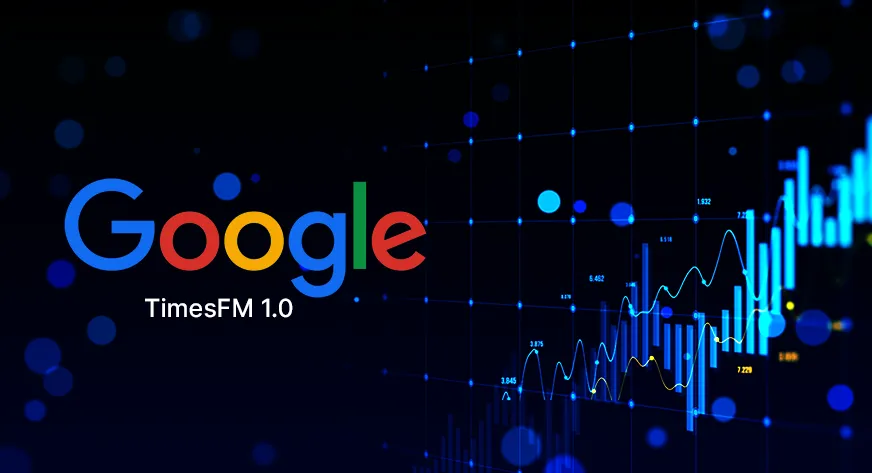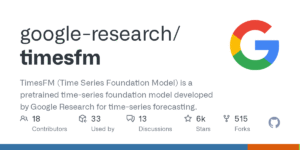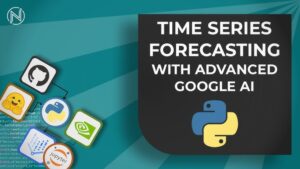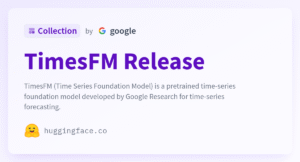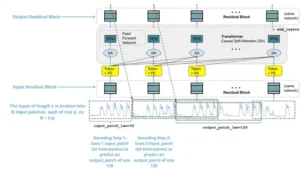Google AI Ships TimesFM-2.5: A Smaller, Faster, Longer-Context Foundation Model for Forecasting
Google Research has quietly upgraded its time-series foundation model: TimesFM-2.5. The new checkpoint is a compact, 200-million-parameter decoder-only model with a much longer context window (16K time-steps), native probabilistic forecasting support, and improved zero-shot accuracy on standard forecasting benchmarks. It’s already available on Hugging Face and rolling into Google Cloud tooling such as BigQuery’s AI.FORECAST, signaling a shift: forecasting is becoming a first-class citizen in the foundation-model era. MarkTechPost+2Hugging Face+2
Below I unpack what TimesFM-2.5 is, why it matters, how it’s built and evaluated, where you can run it, which real-world problems it’s suited for, and the limitations and governance questions that come with deploying foundation models for forecasting.
TL;DR — The headlines
-
What: TimesFM-2.5 — a 200M-parameter, decoder-only time-series foundation model from Google Research. Hugging Face
-
Why it’s notable: Longer context (16K timepoints), built-in probabilistic outputs, and improved zero-shot accuracy that tops the GIFT-Eval leaderboard among zero-shot models. MarkTechPost+1
-
Where to run it: Checkpoint available on Hugging Face; being integrated into Google Cloud products like BigQuery (AI.FORECAST) and Model Garden / Vertex. Hugging Face+1
-
Key use cases: Retail and supply-chain forecasting, energy demand and renewables, financial risk metrics, capacity planning, anomaly detection and what-if scenario analysis.
-
Caveats: Like all pretrained foundation models, TimesFM-2.5 can struggle with distributional shifts, rare event forecasting, and requires careful domain validation and explainability measures.
A brief history: TimesFM in context
TimesFM originated as Google Research’s attempt to bring the “foundation model” concept — pretraining large models on broad data and fine-tuning or performing zero-shot tasks — to time-series forecasting. The original TimesFM paper (ICML 2024) showed promising zero-shot forecasting performance from a relatively small transformer trained on a very large corpus (~100 billion timepoints). That work framed forecasting as a generative, sequence modeling problem and demonstrated that decoder-only transformers can be effective at time-series tasks that historically relied on specialized statistical models. Google Research+1
TimesFM-2.5 is the next step: improvements in architecture/conditioning, longer context handling, and a production-ready checkpoint that Google has released publicly. The company emphasizes both accuracy and practical deployment: smaller model size for cheaper inference, and extended context so forecasters can use months or years of historical data without aggressive windowing. MarkTechPost+1
What’s new in TimesFM-2.5 — the technical highlights
-
200M parameters, decoder-only Transformer.
TimesFM-2.5 keeps model size modest (≈200M params) compared with massive LLMs, because time-series tasks usually don’t need billions of parameters; what matters more is the diversity and volume of timepoints and how the model uses context. The modest size helps reduce inference cost and latency. Hugging Face -
16K context length.
A key upgrade is a long context window — roughly 16,000 time-steps — enabling the model to absorb long historical patterns (seasonality, regime shifts, multiyear cycles) without truncating or downsampling. For many real forecasting problems, retaining that long history is crucial. MarkTechPost -
Native probabilistic forecasting.
TimesFM-2.5 outputs probabilistic forecasts (quantiles and distributions) natively — not just point forecasts. This is essential for risk-aware decision-making (inventory buffer sizes, capacity planning, financial VaR). The model is evaluated on probabilistic metrics (e.g., CRPS) as well as accuracy metrics (e.g., MASE). MarkTechPost -
Strong zero-shot performance (GIFT-Eval leader).
According to Google and independent reporting, TimesFM-2.5 leads zero-shot foundation models on GIFT-Eval across accuracy metrics, suggesting the pretraining corpus and modeling choices transfer well to many downstream series without retraining. This is meaningful because it lowers the barrier for teams that lack labeled, cleaned forecasting datasets. MarkTechPost+1 -
Open checkpoint & ecosystem integration.
Google has published the checkpoint on Hugging Face and is integrating TimesFM into Google Cloud (BigQuery ML / AI.FORECAST and Model Garden). That means practitioners can experiment locally, in managed cloud, or inside SQL pipelines. Hugging Face+1
How TimesFM-2.5 was trained (high level)
TimesFM’s approach follows the “pretrain on huge, diverse timepoints” philosophy:
-
Corpus: A mixture of real-world and synthetic time series amounting to on the order of 100 billion timepoints in earlier releases; TimesFM-2.5 benefits from improved curation and training recipes. The goal of such scale is to capture many temporal patterns across domains (electricity load, retail sales, telemetry, web traffic, finance, etc.). Google Research+1
-
Objective: Autoregressive decoding with conditioning tokens that encode metadata (calendar features, hierarchical identifiers, exogenous covariates). The model learns to predict future windows given history and optional conditioning. Probabilistic outputs are supported via parametrized output heads (e.g., mixtures or quantile heads). arXiv
-
Benchmarks: Zero-shot evaluation uses standardized suites such as GIFT-Eval and other public datasets; TimesFM-2.5 reportedly surpasses prior checkpoints across key metrics. MarkTechPost+1
Where you can run TimesFM-2.5 today
-
Hugging Face: Google has published the TimesFM-2.5 checkpoint (google/timesfm-2.5-200m-pytorch), allowing users to download weights, run inference locally, and inspect tokenizer/conditioning code. This makes experimentation and reproducibility straightforward for researchers and data teams. Hugging Face
-
BigQuery / BigQuery ML: Google is embedding TimesFM in BigQuery’s AI.FORECAST function and related tutorials. That enables analysts to run forecasting directly from SQL over warehouse data — a pragmatic way to operationalize forecasts into dashboards and pipelines. Google Cloud+1
-
Model Garden / Vertex AI: Google’s Model Garden and Vertex AI integrations are expected to make large-scale batch or online inference manageable for enterprise workloads (noticeably useful for teams that need scalable serving and monitoring). Google Cloud
Real-world use cases where TimesFM-2.5 shines
-
Retail and supply-chain forecasting.
Retailers can use long history (promotions, holidays) and probabilistic forecasts to set safety stock, schedule replenishments, and plan cross-docking. TimesFM-2.5’s long context helps capture multi-year seasonality and promotion cadence. MarkTechPost -
Energy load and renewables forecasting.
Electricity demand and renewable generation are highly temporal and seasonal. Probabilistic forecasts allow grid operators to quantify uncertainty and allocate reserves. The long context helps capture seasonal climate patterns and multi-year trends. MarkTechPost -
Finance and risk (Value-at-Risk, liquidity planning).
As researchers have explored (and external papers have tested TimesFM variants), foundation models can be used to estimate tail risk and conditional distributions when trained and validated properly. Care must be taken with nonstationary financial regimes. arXiv -
Capacity planning and infrastructure telemetry.
Cloud and online services can use forecasts of traffic, latency, and errors to autoscale services and avoid SLA breaches. The 16K context lets engineers retain long windows of telemetry to detect slowly developing trends. MarkTechPost -
Anomaly detection & root cause analysis.
Forecasting models naturally provide residuals and probabilistic intervals — useful signals for flagging anomalies. When combined with attribution tools, forecasts can support incident triage and RCA workflows. Google Cloud
Comparison to other forecasting models
TimesFM sits in a new class of foundation time-series models (alongside other entrants such as TimeGPT and various encoder-decoder alternatives). Compared with classical statistical models (ARIMA, ETS) and specialized machine learning models (XGBoost, DeepAR), TimesFM’s strengths are:
-
Zero-shot transfer: Good out-of-the-box performance on many series without per-series retraining. Google Research
-
Unified modeling: One model can handle different granularities and domains, reducing model sprawl.
-
Probabilistic outputs: Native uncertainty quantification that scales across series.
Weaknesses include sensitivity to domain shift, limited interpretability compared to simple linear models, and the need for good metadata/conditioning to get the best results. Practical deployments often combine TimesFM with lightweight per-series fine-tuning or ensembling with domain experts. Medium
Limitations, risks, and responsible deployment
No model is a magic bullet. TimesFM-2.5 brings important advances, but practitioners must treat it as a tool, not an oracle.
Key limitations and risks:
-
Distributional shifts & rare events: Pretrained models can struggle when the future regime differs substantially from training data (pandemics, supply-chain shocks). Tail events and black-swan scenarios require domain controls and scenario planning.
-
Overreliance on zero-shot outputs: While zero-shot is powerful, teams should validate forecasts with historical backtesting on their own series and metrics (MASE, sMAPE, CRPS). MarkTechPost
-
Explainability and governance: Forecasts feed operational decisions; organizations must instrument monitoring, alerting, bias checks, and human-in-the-loop signoffs.
-
Data privacy and provenance: Pretraining on broad corpora raises questions about data provenance; when integrating enterprise covariates, ensure privacy and access controls.
-
Model drift & retraining: Forecast quality can degrade over time; pipelines for drift detection and retraining are essential.
Google’s move to publish the model and integrate it into analytics tooling helps transparency and reproducibility, but responsible adoption still requires careful MLOps and domain oversight. Google Cloud+1
Practical tips for teams trying TimesFM-2.5
-
Start with Hugging Face for experimentation. Download the checkpoint and run offline tests on representative series; measure CRPS and MASE against your current baseline. Hugging Face
-
Use BigQuery AI.FORECAST for analytics teams. If your data lives in Google Cloud, try the AI.FORECAST function to quickly prototype forecasts inside SQL and dashboards. This lowers friction for non-ML teams. Google Cloud
-
Condition wisely. Provide calendar features, exogenous regressors (price, promotions, weather) and series identifiers where applicable — TimesFM performs best when it can use rich conditioning tokens.
-
Calibrate and ensemble. For high-stakes forecasts, ensemble TimesFM outputs with domain models or calibrate quantiles on holdout data.
-
Monitor in production. Track forecast errors, interval coverage, and business KPIs; set automated alerts for drift and upgrade the model when necessary.
What this means for the forecasting landscape
TimesFM-2.5 signals several broader trends:
-
Specialized foundation models are practical and valuable: not everything needs an enormous LLM. Domain-specialized foundation models (vision, speech, time-series) can deliver strong gains while keeping costs manageable. Google Research
-
Forecasting becomes embedded in analytics: integration into BigQuery and cloud model registries shows that forecasting will increasingly be part of SQL-first analytics workflows rather than isolated ML projects. Google Cloud
-
Lower barrier to entry: Zero-shot performance and public checkpoints democratize access for small teams and researchers who previously lacked the data or compute to build strong forecasting systems. Hugging Face
Final thoughts
TimesFM-2.5 is a practical, well-engineered step forward for time-series foundation models: compact enough to be cost-effective, long-context enough to capture realistic temporal patterns, and probabilistic enough to support risk-aware decisions. The public checkpoint and cloud integrations make it easy to try — but the usual engineering caveats apply. Validate on your data, put governance and monitoring in place, and treat the model as an augmentation to domain expertise rather than a replacement.
For teams struggling with fragmented forecasting pipelines, TimesFM-2.5 offers a tempting simplification. For researchers, it’s another data point showing that small, well-trained foundation models can have outsized practical value. Expect to see more vertical foundation models like this — in forecasting, anomaly detection, and domain-specific forecasting — over the next 12–24 months as organizations operationalize pretrained models into analytics and decision workflows. MarkTechPost+2Hugging Face+2
Sources and further reading
Selected primary sources used for this article:
-
TimesFM-2.5 model page on Hugging Face (google/timesfm-2.5-200m-pytorch). Hugging Face
-
MarkTechPost coverage: “Google AI Ships TimesFM-2.5: Smaller, Longer-Context…” (release summary). MarkTechPost
-
Google Research blog and original TimesFM paper (ICML 2024): “A decoder-only foundation model for time-series forecasting.” Google Research+1
-
BigQuery / Cloud blog posts on TimesFM integration and AI.FORECAST. Google Cloud+1
For quick updates, follow our whatsapp –
https://whatsapp.com/channel/0029VbAabEC11ulGy0ZwRi3j
Google’s Gemma 3 270M — the tiny titan for on-device and edge AI

